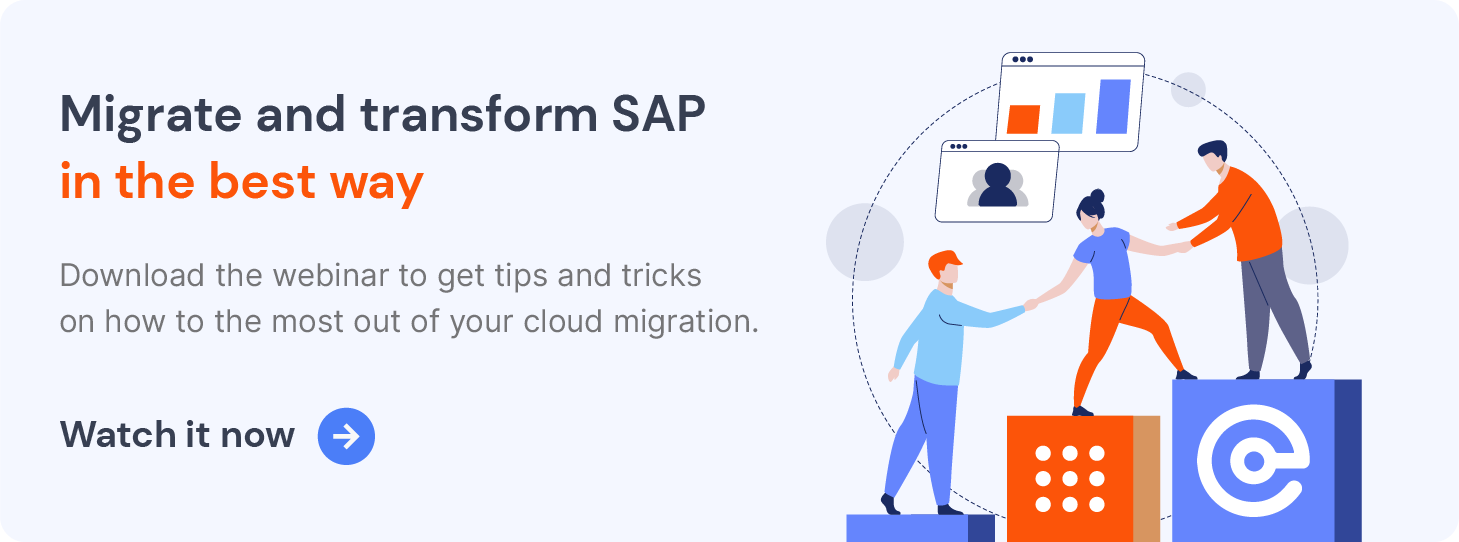When you move to the cloud, there's huge potential for innovation and increased flexibility, but many organisations are falling short of realising their cloud migration goals with less than optimal migration strategies.
When considering the transformation of your SAP landscape, there will be a number of decisions to make.
- Would we benefit from a move to S/4HANA?
- Can we just lift our current system to the cloud?
- Should we simply move our current system to the cloud?
These answers will be dependant on your organisation, desire to modernise and road mapped activity to name a few. However, we are seeing an increased shift in the market to ECC on Azure using our migrate & transform approach.
What is migrate and transform
It's not enough to just 'lift and shift'. Our 'migrate and transform' process focuses on modernising application landscapes to take full advantage of the cloud. This helps you unlock savings by moving SAP ECC to Azure.
The pandemic forced organisations to rethink their way of working. A study from Gartner showed that this disruption was positive for most businesses, resulting in the following:
- Acceleration of business initiatives to drive innovation.
- Improved operational excellence.
- High levels of cost-optimisation.
All of these are benefits you can better realise through a migrate and transform approach compared to a simple 'lift and shift'.
.png?width=877&name=Untitled%20(4).png)
To get more of an idea of how businesses can take advantage of these benefits, let's take a look at a real-world case.
Responding to the demands of the pandemic, a well-known retailer implemented S/4HANA on Azure. As a result, they've seen their business grow from eight percent of sales in 2019 to 25 percent in 2020. And they were able to set up dedicated distribution centres in just eight days.
This retailer's story is a perfect example of a business that innovated efficiently. Migrating and transforming allowed them to be more resilient and agile. This meant they could respond effectively to market threats and leverage emerging digital opportunities to better serve their customers.
Considerations for migrate and transform
With the 2027 cutoff date for ECC support looming ahead, it's crucial that those two-thirds of SAP customers who haven't migrated to the cloud to at least start thinking about it.
That said, there are a few things you need to consider before you migrate and transform:
- The compatibility of your systems with the cloud.
- What systems you should move first.
- How much downtime your business can tolerate.
- What mechanism you will use to transfer files and data.
- How much capacity you have to run migration tools.
Evaluating these factors beforehand will help you plan for any potential issues, and ensure your migration goes smoothly.
The four pillars of your migration strategy
To make SAP as cloud-native as possible when migrating to Azure, we've come up with four pillars to integrate into your cloud strategy:
1. Standardisation
By standardising the platform, you promote simplicity, increase uniformity and increase in-depth knowledge.
2. Rationalisation
This pillar allows you to do more with less, enables you to use what you need, when you need it, and reduces waste.
3. Modernisation
The aim of modernisation is to embrace the change and benefits that Azure brings. All while enhancing security standards and visibility.
4. Automation
Automation increases consistency while eliminating human error by allowing you to build and runtime automation.
By building your migration strategy around these four pillars, you can unlock the agility of the cloud, while being able to test business processes and implement upgrades with minimal impact.
Begin your transformation journey
Migrating to the cloud will help your business become more flexible and efficient. But only if you implement using the right strategy.
When you migrate and transform your SAP systems with us, you get a highly standardised platform that accelerates innovation. And because we've achieved Advanced Specialisation for SAP on Azure, you know you can trust us in the delivery.
To find out more, download our migrate and transform webinar here.



